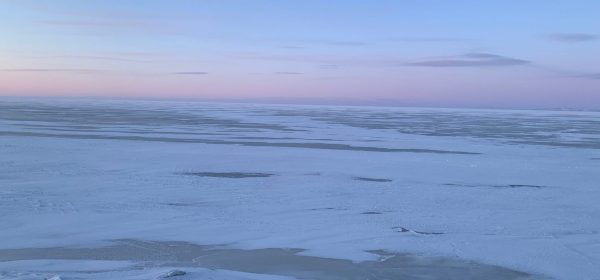
KOTZEBUE – Much of Alaska had been in a deep freeze this week, with temperatures as low as minus 60 degrees Fahrenheit. That’s in stark contrast to the rest of the year, which saw record warmth and major disruptions of the sea ice across the Arctic.
Temperatures in the Northwest Arctic villages of Ambler and Buckland reached minus 42 degrees on Thursday morning. The Interior village of Allakaket had the coldest temperature in the state Thursday at minus 56 degrees, and it was minus 65 in Manley Hot Springs near Eureka. That’s one of the lowest temperatures for anywhere in Alaska in years.
Simply put, the state was cold this week.
Rick Thoman, a climatologist with the International Arctic Research Center in Fairbanks, says it’s a dramatic drop from this winter’s balmy start, but this is a normal weather pattern for this time of year.
“We’ve just gotten so accustomed to these persistent runs of above normal weather that even somewhat below normal for more than a day or two really seems outstanding,” Thoman said.
Thoman says this last-minute cold snap likely won’t prevent Alaska from having a record-breaking year.
“Twenty-nineteen is, at this point, virtually certain to be the warmest year of record for Northwest Alaska, and the state as a whole,” Thoman said.
Thoman says the cold snap is helping create sturdy sea ice, after record-low growth this winter.
“The cold weather has helped to finally pretty much freeze over the Chukchi Sea, very late freeze-up, and now starting to work on the Bering Sea. So that’s all good news for moving forward as we move into spring,” he said.
That’s good news for a lot of Arctic communities who rely on sea ice for travel and subsistence hunting.
Claude Wilson is on the board of directors for the Iron Dog Snowmachine Race and puts on local races in Kotzebue. He says he regularly checks on the ice.
“You know, trying to keep track of the thickness because we don’t want people taking their vehicles out on the ice unless it’s safe,” Wilson said.
For Wilson, safe for racing means thicker than a foot of sea ice.
“Year’s past, it was always a go because we always had more than two feet of ice,” Wilson said.
This year, Wilson saw ice as thin as five inches this spring, which made him and other organizers nervous. He says the recent cold snap has made him more hopeful that the ice will be thick enough to race this winter, with ice readings earlier this month at 14 inches near shore, and thicker towards the ocean.
Wilson says he wants to continue to see temperatures below zero.
“I think every ten days, it adds an inch to the thickness,” Wilson said, “so we’re hoping it’ll be a little thicker than it was just nine days ago.”
If the ice remains solid, Wilson will be able to put on the annual Knight Rider Snowmachine race in Kotzebue on New Year’s.
Wesley Early covers Anchorage life and city politics for Alaska Public Media. Reach him at wearly@alaskapublic.org and follow him on X at @wesley_early. Read more about Wesley here.





